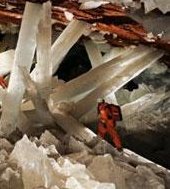
November Editorial
Cave of Crystals

November Editorial
Cave of Crystals
|
|
In Spanish it is known as 'Cueva de los Cristales' and it is probably the most beautiful natural display of crystals in the world. What is breathtaking is not only the the size (although they are absolutely huge) but also the purity and the number of crystals on display. This cave contains some of the largest natural crystals known in the world – translucent beams of selenite, a crystalline form of the mineral gypsum, which are up to 36 feet long. The cave is buried a thousand feet (about 300 meters) below Naica mountain in the Chihuahuan Desert of Mexico. It is part of the a silver and zinc mine near the mountain and was discovered in 2000 by two brothers who are miners, Juan and Pedro Sanchez, whilst they were excavating a new tunnel for a commercial lead and silver mine. Naica is a a very special mountain. It sits on a set of fault lines (planar rock fractures which show evidence of relative movement). Superhot metal-rich fluids circulate throughout the mountain, heated by a magma chamber buried two and a half kilometers below. The fluids travel through the mountain's fault lines, depositing veins of lead, zinc and silver ore. The Naica mine was first discovered south of Chihuahua City by early prospectors in 1794. These prospectors struck a vein of silver at the base of a range of hills called Naica by the Tarahumara Indians. From that discovery until around 1900, the primary interest was silver and gold. Around 1900 large-scale mining began as zinc and lead became more valuable. During the Mexican Revolution the mine was producing a great deal of wealth. Revolutionary troops entered the town and demanded money from the owners. One of them was assassinated when he refused to pay, causing the mine to shut down between 1911 to 1922. Just before the mine was closed, the famous 'Cave of Swords' was discovered at a depth of 400 feet, which is part of the same underground system as the Cave of crystals. Before the the lastest discovery, the 'Cave of Swords' contained the largest previously known crystals. Unfortunately many of the crystals have been collected, (some of these are now on display at the Smithsonian Institution). Nevertheless, the 'Cave of Swords' is still a fascinating cave to visit. So how were the giant crystals formed? This question has fascinated geologists ever since the discovery of the Cave of Crystal. In 2007 a paper published in the journal Geology by geologist Juan Manuel García-Ruiz of the University of Granada in Spain reported that the crystals slowly grew over millennia while the cavern was flooded with hot, mineral-saturated water. The magma chamber two to three miles below the mountain contains very hot lava. The heat from this compressed lava travels through the faults up into the area of the mine. Super heated fluids carry the mineral-rich sludge which formed the crystals as well as the mineral veins. Although the mine is ventilated, making it possible for miners to work there, the Cave of Crystal is not, and there you feel the heat from the magma deep below. The fluids travel along the Naica fault, and enter voids in the bedrock creating hot humid conditions which are quite extreme. The temperatures in the cave are continuously around 136 degrees Fahrenheit (58 degrees Celsius) and the humidity is over 80-percent. The crystals thrive in these conditions, which is the reason for this magical display. Some of the crystals are extremely old. Indeed, the largest crystal found at Naica is 500,000 years old. But be aware that although for crystals these are near perfect conditions, for human body the atmosphere in the cave is a death trap. With the 80% humidity, the body is prevented from sweating to cool itself and as a consequence it starts to slowly cook. Even in specially-designed protective suits, the team of researchers had about 30 minutes before they had to leave the cave. Without the protective suits, one minute is probably what the human body can stand. But the local government and the mine owners hope that they can turn the cave into a museum preserving the minerals in situ. The mining company plans to air-condition the cave, which will lower the temperature gradually, thus preserving the crystals, but making the place more habitable to tourists. If all goes to plan the tourists will be welcomed in few months time. There is a legend that Merlin, the magician of King Arthur, lies sleeping in a crystal cave. With this latest discovery, the legend has come a step nearer reality - who knows but that there was not a similar cave in Arthurian Britain? |
| _______________________________ | ||||
| Home | | | Shopping | | | Database |
© Biscuit Software 2004-2015
All rights reserved